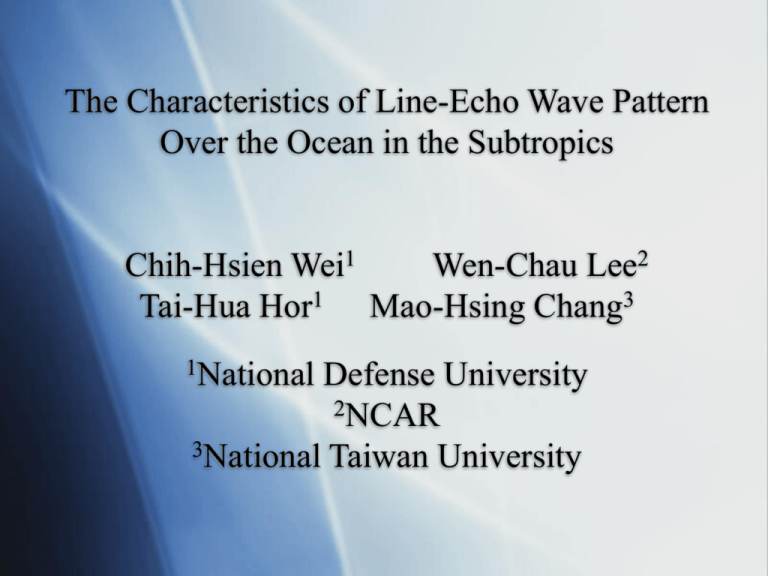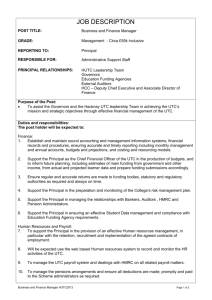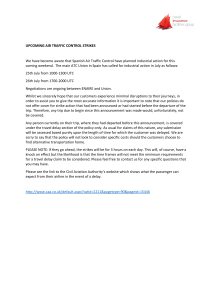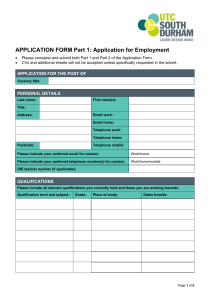Presentation
advertisement

The Characteristics of Line-Echo Wave Pattern Over the Ocean in the Subtropics Chih-Hsien Wei1 Wen-Chau Lee2 Tai-Hua Hor1 Mao-Hsing Chang3 1National Defense University 2NCAR 3National Taiwan University Line Echo Wave Pattern (LEWP) A special configuration in a line of convective storms that indicates the presence of a low pressure area and the possibility of damaging winds and tornados. In response to very strong outflow winds behind it, a portion of the line may bulge to form a bow echo. Nolen, R. H., 1959: A radar pattern associated with tornadoes. Bull. Amer. Meteor. Soc., 40, 277279. Nolen (1959) An LEWP was defined as “…a configuration of radar echoes in which a line of echoes has been subjected to an acceleration along one portion and/or a deceleration along that portion of the line immediately adjacent with a resulting sinusoidal mesoscale wave pattern in the line”. LEWP and Bow Echo Other studies also indicated that severe straight line winds and tornados occurred within LEWP (e.g., Cook 1961; Hamilton 1970). The concave-shape radar echoes associated with downburst activities were named “bow echo” by Fujita (1978). Fig1. Schematic diagram of the evolution of a bow echo. (from Fujita 1978) FIG. 2. Radar analysis of the central Minnesota derecho between 2047 and 2112 UTC from Minneapolis–St. Paul, MN (MSP). Reflectivity contours are 18, 30, 41, and 46 dBZ. Shaded region represents reflectivity values greater than 50 dBZ. Arrow indicates the position of rear-inflow notch (From Przybylinski 1995) (from Johns and Hirt 1987) Fig. 3 Illustration of the primary evolutionary pathways for bow echoes observed by Klimowski (2004). The number of cases identified following each path is indicated above the arrows. References for representative bow-echo cases are given. The percentage of bow echoes preceded by merging storms is given at right. a 2003-06-06 1200 UTC Makung Sounding b 2003-06-06 1200 UTC Pingtung Sounding Fig. 6 Skew-t diagrams from (a) Makung sounding and (b) Pingtung sounding at 1200 UTC 6 June 2003. CAPE~2000 J Kg-1 Shear ~ 13 m s-1 Fig. 7 The vertical wind shear between 1000 and 700 hPa at 1800 UTC 6 June and 0000 UTC 7 June 2003. The unit of contour is ms-1. Fig. 8 The enhanced infrared imagery of GOES-9 satellite at 0000 UTC 7 June 2003. The bolded dash line represents the position of surface front. A A ~158 km B B B C C D D D E E Fig. 9 The reflectivity of elevation of 0.5 degree from RCCG radar (0003 and 0203 UTC) and RCKT radar (0307, 0435 and 0603). The shaded area stand for echoes of 30, 40 and 45 dBZ, respectively. Symbol represents the position of Pingtung sounding station. Ground Relative 2003-06-07 0204 ~ 0220 UTC 2 km CAPPI VB Storm Relative 2003-06-07 0236 ~ 0252 UTC 2 km CAPPI VB 2003-06-07 0308 ~ 0316 UTC 2 km CAPPI VB 2003-06-07 0308 ~ 0356 UTC 2 km CAPPI VD 2003-06-07 0412 ~ 0500 UTC 2 km CAPPI VD a b + = c Fig. 17 The simulation of ideal flow pattern. (a) a Rankin vortex, (b) westerly and southwesterly divided by a diagonal and (c) combination of the ideal wind. Observation a b c Simulated wind d e f Fig. 18 Comparisons between observational and simulated Doppler velocity at (a) 0340 UTC, (b) 0428 UTC and (c) 0500 UTC for vortex VC, as well as (d) to (f) are simulated flow patterns, respectively. The X and Y axis are the east-west and south-north distances far from radar site. 2003-06-07 RCKT 1 km tangential wind 0348 UTC a 0420 UTC c 0404 UTC b 0436 UTC d Fig. 19 The mean tangential wind for vortex VC derived by ground base velocity track display (GBVTD) scheme at 1 km in height. (a) 0348, (b) 0404, (c) 0420 and (d) 0436 UTC. The contour represents wind field. The shaded area stands for reflectivity of 30, 35 and 40 dBZ, respectively. Symbol “+” is the position of vortex center. The arrow points out maximum speed. a d VORTEX RIJ VORTEX VORTEX e b Radar — c Radar Radar f Radar — + — + 0 Fig. 20 The conceptual model for the associated vortices of (a) classical bow echoes and its signature deduced by single Doppler observation from various radar site. (b) radar at the east and (c) radar at north of system. (d) represents non-classical bow-shaped systems observed in the study. (e) and (f) represent the same meaning as (b) and (c) The straight line and curve stand for zero contour of Doppler velocity. Thank You! 2003-06-07 0404 ~ 0420 UTC 2 km CAPPI VC 2003-06-07 0432 ~ 0452 UTC 2 km CAPPI VC







